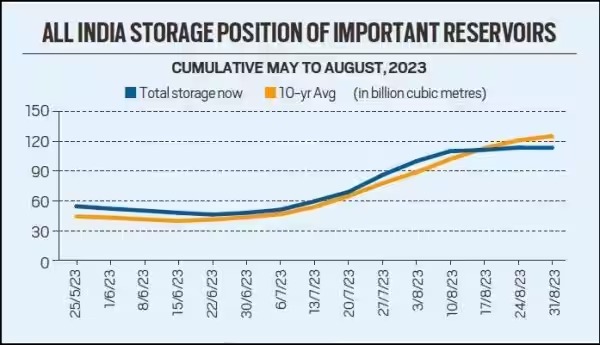Latest Updates
150 reservoirs across India flag a major shortage in their water storage levels

India is heavily dependent on the annual rainfall for a plethora of activities, ranging from agriculture to power generation to regular household activities and industry. Its rivers and reservoirs are fed by the annual rainfall, however, the rainfall deficit that made August the driest month in about 15 years, has had a detrimental impact on these sources of water. At least 150 reservoirs in India that are a crucial source of water for the rest of the year are 10% below the last 10 years cumulative. The water levels in these reservoirs have gone down below what is considered to be the normal level in the month of August.
The Central Water Commission has notified that as of August 31, these 150 reservoirs across the country had about 113 billion cubic meters of water, which in comparison to the ‘normal’ level that is expected in the month of August, shows a 10% deficit. The study shows that the reservoirs in the Southern states, where the rainfall was scanty in August have flagged shortages in their water storage. In the normal course, these reservoirs collectively are full to at least 67% of their capacity, however, this year in August, the 42 reservoirs in this region accounted for only 49% of their combined capacity.
These reservoirs play a pivotal role in supplying water for various activities for the rest of the year, and they are fed during the four-month southwest monsoon season every year. August is usually the month that accounts for nearly 22% of the annual rainfall, and that in turn, leads to the rise in storage levels in these reservoirs. However, August of 2023 has been the driest in over 15 years, experiencing only 162mm of rain across the country, as opposed to the 255mm that is expected, making a 36% deficiency.
As reported by Reuters, the dry August also saw an increase in power demand to fuel irrigational activities. Given the dwindling water levels of these reservoirs, the demand could not be satiated by hydraulic means, ergo; additional coal-fired power plants were employed to meet these rising needs. The report further said that the share of coal in India’s total power generation increased to 66.7% in August, the highest for the month in six years. This in turn has flagged concerns over climate change issues. September is expected to quench some of these water deficiencies.









